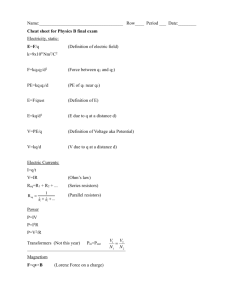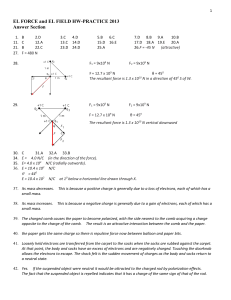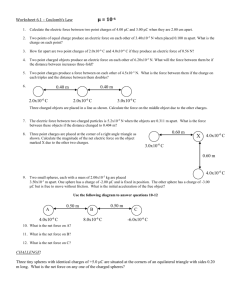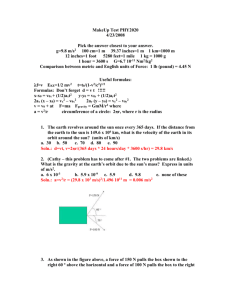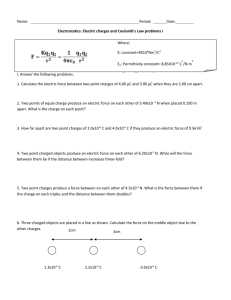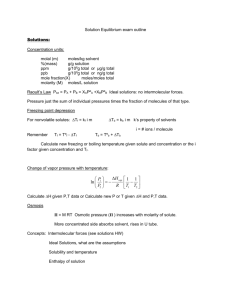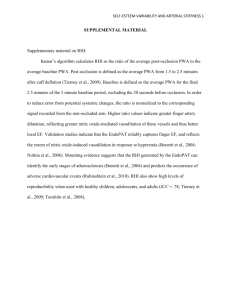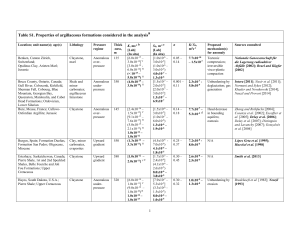Document
advertisement
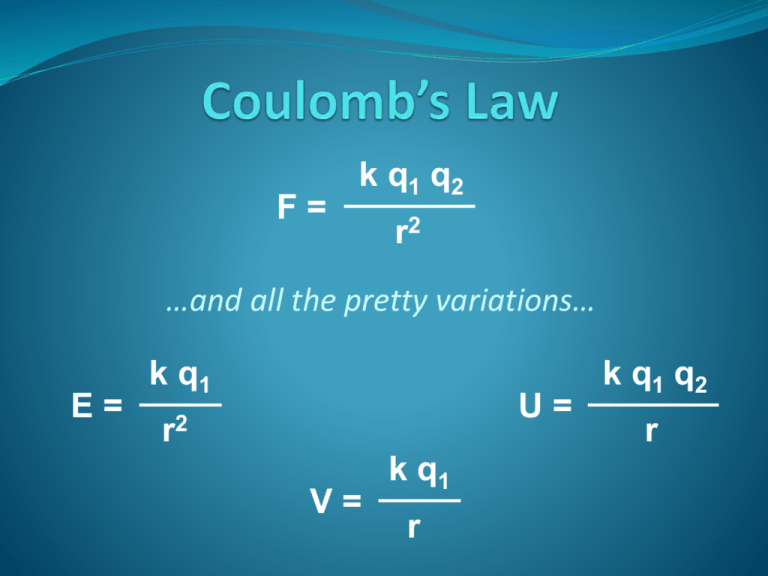
F= k q1 q2 r2 …and all the pretty variations… E= k q1 U= r2 V= k q1 r k q1 q2 r Universal Gravitation Constant Mass of each object (the stuff that creates the force) G m1 m2 F= r2 G = 6.67 x 10-11 N∙m2/kg2 Distance Between Objects Coulomb’s Constant Charge of each object (the stuff that creates the force) k q1 q2 F= r2 k = 9.0 x 109 N∙m2/C2 Distance Between Objects Charges are measured in units of Coulombs (C) Similarities Essentially the same formula Vary directly as the amount of “stuff” Vary inversely as the square of the distance Constants just set units Differences Gravity force is always toward the other mass, electrostatic force can be either direction depending on sign of the charges Positive (+) means they repel Negative (-) means they attract 1. A negative charge of -3.0x10-6 C and a positive charge of 4.0x10-6 C are separated by a distance of 3 mm. What is the force on the negative charge? (magnitude and direction) q1 = -3x10-6 C q2 = 4x10-6 C r = 3x10-3 m (9x109)(-3x10-6)(4x10-6) F= (3x10-3)2 Fneg charge = 1.2x104 N toward the positive charge 2. What is the force on the positive charge? Fpos charge = 1.2x104 N toward the negative charge Strength at position where second mass would be F GGmm 1 m 1 2 g = F == 2 2 r m2 Units are N/kg, or m/s2 Strength at position where second charge would be F kkqq 1 1q2 E = F == 2 2 r q2 Units are N/C, or V/m 3. What is the electric field at the location of the positive charge due to the negative charge? q1 = -3x10-6 C q2 = 4x10-6 C r = 3x10-3 m (9x109)(-3x10-6) E= (3x10-3)2 or -1.2x104 E= 4x10-6 E = 3.0x109 N/C from positive to negative charge 4. A positive 6.0x10-9 C charge experiences a force of 1.8x10-5 N to the right. What is the electric field at the location of that charge from other charges? F = 1.8x10-5 N q2 = 6x10-9 C 1.8x10-5 E= 6x10-9 E = 3000 N/C to the right The electric field always comes out of a positive charge and into a negative charge: - + + - 5. What is the direction of the electric field between the two charges of problem 1? Electric Field always goes from positive to negative! F= k q1 q2 r2 …Yay! E= k q1 U= r2 V= k q1 r k q1 q2 r (sign only for convention) Potential energy of the pair of masses -GGm m11m m22 ·r U=F F·r = 2 rr Units are N·m, or J Potential energy of the pair of charges k q1 q2 ·r U=F F·r = 2 rr Units are N·m, or J 1. A negative charge of -3.0x10-6 C and a positive charge of 4.0x10-6 C are separated by a distance of 3.0 mm. What is the potential energy of the charge pair? q1 = -3x10-6 C q2 = 4x10-6 C r = 3x10-3 m (9x109)(-3x10-6)(4x10-6) U= 3x10-3 U = -36 J (toward each other) 2. Two positive charges of 6.0 μC are 2.0 cm apart. What is the potential energy of the charge pair? q1 = 6x10-6 C q2 = 6x10-6 C r = 2x10-2 m (9x109)(6x10-6)(6x10-6) U= 2x10-2 U = 16.2 J (away from each other) Electric Potential based on charge and distance… k q1 V=E E·r = 2 ·r rr …or from potential energy U k kqq 1 1q2 V = U == r r q2 Units are J/C, or V 3. What is the electric potential at the location of the positive charge due to the negative charge? q1 = -3x10-6 C q2 = 4x10-6 C r = 3x10-3 m (9x109)(-3x10-6) V= 3x10-3 or V= -36 4x10-6 V = -9.0x106 V 4. Two parallel plates create an electric field between them of 6.0x103 V/m. If the plates are 2.0 mm apart, what is the potential difference between the plates? 6x103 E = V/m -3 r = 2x10 m V = E·r = (6x103)(2x10-3) V = 12 V 5. A +4 nC charge and a -4 nC charge are 1.0 m apart. What is the electric field and electric potential at a point half way between them? + 0.5m +4 nC ELECTRIC FIELD 0.5m -4 nC ELECTRIC POTENTIAL E1 = (9x109)(4x10-9)/.52 = 144 V1 = (9x109)(4x10-9)/.5 = 72 E2 = (9x109)(-4x10-9)/.52 = -144 V2 = (9x109)(-4x10-9)/.5 = -72 E = E1 + E2 = 288 N/C → V = V1 + V2 = 0 V The Big Picture VECTOR has DIRECTION Force k q1 q 2 F= r2 F E= q2 U = F·r N Electric Field N/C or k q1 E= 2 r V/m V = E·r J V V= Potential Energy k q1 q2 U= r U q2 Potential Difference k q1 V= r SCALAR no DIRECTION
